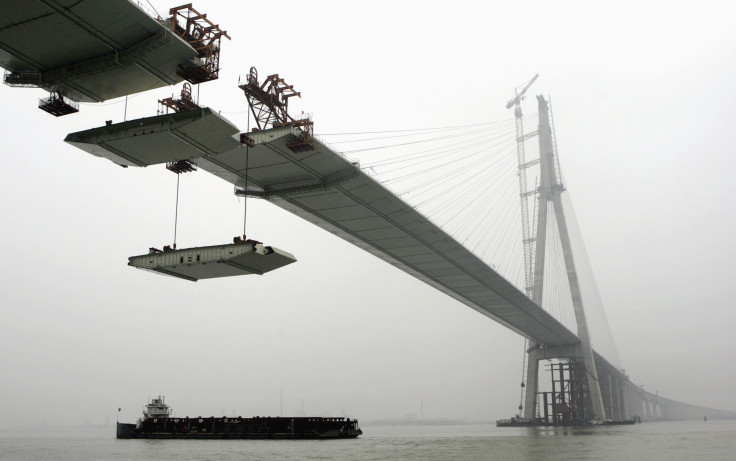Asian Shares Mostly Lower As China Revises 2014 GDP Figure Down; Tokyo, Shenzhen Buck Trend

SHANGHAI -- Asian shares closed generally lower Monday, amid anxiety over upcoming Chinese trade figures -- as the government in Beijing revised its figure for the country’s GDP growth for last year down, from 7.4 percent to 7.3 percent.
The main Shanghai Composite Index closed 2.5 percent lower, continuing its falls of the previous week. Hong Kong’s Hang Seng also fell, by 1.2 percent, while in Sydney the ASX 200 was down 0.2 percent. South Korea’s Kospi Index closed 0.15 percent lower, and Singapore’s Straits Times Index was down almost 0.4 percent in late trading.
The only bright spots were the Nikkei in Tokyo -- which was up 0.4 percent after falling last week to its lowest point for seven months -- and China’s secondary markets: the Shenzhen Composite Index was up 0.2 percent, while the ChiNext index for high-tech stocks, traditionally China’s most volatile index, was up 2 percent, after falling almost 8 percent over the previous two trading days.
Analysts said the mixed Chinese results reflected contradictory factors. Early in the day, investors had been cheered by comments made by the country’s central bank governor Zhou Xiaochuan at the G20 finance ministers' meeting on Sunday, in which he said that “most of the correction of the stock market has taken place,” and suggested that the Chinese yuan, which was devalued around 2.8 percent in August, had basically stabilized.

China's markets -- which have fallen 40 percent in the past two months -- were also buoyed in morning trading by a report from China’s Xinhua news agency, which quoted an unnamed official from China’s market regulator, China Securities Regulatory Commission (CSRC), as saying the market bubble and associated risks “have been deflated to a considerable extent.” The official added, crucially, that the Chinese government would continue to intervene if market volatility led to a “systemic risk.”
He said it would “take decisive and timely measures” to prevent “severe, abnormal fluctuations in the markets” -- contradicting recent speculation that the authorities would not continue with efforts to stabilize the markets indefinitely. The official also said the CSRC was considering a “circuit breaker mechanism” to prevent future market volatility, though no details were given.
Analysts had mixed feelings about these comments, with some fearing that they would encourage small investors back into the market, which remains volatile, and is still about 50 percent higher than its level before it began its bull run in the summer of last year. However, that didn’t stop the regulators' reassuring words about the markets being made headline news in Monday’s Chinese newspapers -- which have kept stories about recent market falls off the front pages in recent weeks.

But market sentiment was dented later in the day by the revision of China’s official GDP statistics for last year, down 0.1 percent, leaving the country’s 2014 GDP at $10 trillion, $32.4 billion lower than previously announced. China’s National Bureau of Statistics also said that the secondary industrial sector’s share of GDP was 0.1 percentage point higher than thought, at 42.7, while the contribution of the tertiary sector, mainly service industries, was 0.1 percent lower, at 48.1.
Analysts said the move was not unprecedented. Andy Rothman, China strategist at fund managers Matthews Asia, told International Business Times that China “periodically makes these revisions” -- though some commentators said it was unusual for the revision to be downward rather than up. Some observers said the announcement was a positive sign, indicating that China’s economic data is becoming more transparent and reliable -- though others suggested the move could also be designed to help make this year’s economic figures look less bad by contrast.
And nerves remain ahead of the announcement of China’s latest economic data, with figures for exports in August due to be announced Tuesday. It was a fall of 8.3 percent in China’s export figures for July that sent panic through global markets last month -- and was followed shortly after by China’s unexpected decision to devalue its currency.
Some Chinese economists have already predicted that overall growth for the third quarter of the year could be 6.8 percent, compared to 7 percent for the first half of the year. However analysts at ANZ Bank said in a note Monday that they had revised their forecast for third-quarter GDP down to 6.4 percent, though they said growth might rebound to 6.8 percent in the final quarter of the year. The analysts expected industrial production growth to have risen to 6.3 percent in August compared to a year earlier -- up from 6 percent in July -- but added that last week’s Purchasing Manager’s Index figures of manufacturing output suggested that the sector remained weak.

The Chinese government body in charge of economic planning, the National Development and Reform Commission, said Monday that its latest figures showed the economy was stabilizing and on the brink of an upturn. It said on its website that indicators ranging from power use, rail freight, home prices and transactions have all “taken a favorable turn,” state media reported.
The body also predicted that China's exports will grow for August. But analysts will keenly watch data on both trade and inflation to be released later this week for further signs of where the world's second largest economy is headed.
© Copyright IBTimes 2024. All rights reserved.












